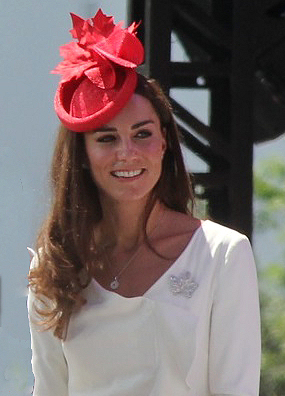Fascinator
Fascinator is a headpiece, a style of millinery that has been popular at various periods in history and has seen a resurgence in the 21st century. Unlike traditional hats, fascinators are often smaller, featuring decorative designs without a full hat's brim or crown. They are typically attached to the wearer's head using a headband, comb, or clip. Fascinators are commonly worn at formal events, such as weddings, church gatherings, and horse racing events, particularly in the United Kingdom and Australia.
History[edit | edit source]
The term "fascinator" originally referred to a fine, lacy head covering akin to a shawl and made from wool or lace. The term was first used in the 17th century but the concept of decorating the head with feathers, flowers, and other adornments dates back much further. In the 20th century, the term evolved to refer to a formal headpiece, often seen as an alternative to hats for formal occasions, especially among high society and royalty.
Design and Style[edit | edit source]
Fascinators vary widely in style, ranging from simple and elegant designs to elaborate structures adorned with feathers, beads, flowers, and netting. They can be made from a variety of materials, including fabric, wool, and sinamay (a type of straw). The choice of design and material often depends on the occasion, the wearer's outfit, and personal preference.
Cultural Significance[edit | edit source]
In the UK, fascinators have been closely associated with the Royal Family and are a common sight at British weddings and horse racing events, such as the Royal Ascot. They became particularly popular in the early 21st century, partly due to their frequent appearance in the media during royal events. In Australia, fascinators are often worn at the Melbourne Cup, Australia's most famous annual horse racing event.
Modern Usage[edit | edit source]
Today, fascinators are not only worn for their traditional appeal but also as a fashion statement. They offer a stylish alternative to hats and are popular among women who wish to add a touch of elegance and sophistication to their formal attire. The resurgence of fascinators in popular culture has been attributed to their versatility and the creative freedom they offer in terms of design and expression.
Controversies[edit | edit source]
Despite their popularity, fascinators have been the subject of some controversy, particularly regarding their appropriateness at certain events. For example, in 2012, the Royal Ascot updated its dress code to require that women wear hats, not fascinators, in certain areas of the venue. This decision sparked debate about traditional dress codes and the modern interpretation of formal attire.
See Also[edit | edit source]
Search WikiMD
Ad.Tired of being Overweight? Try W8MD's physician weight loss program.
Semaglutide (Ozempic / Wegovy and Tirzepatide (Mounjaro / Zepbound) available.
Advertise on WikiMD
|
WikiMD's Wellness Encyclopedia |
| Let Food Be Thy Medicine Medicine Thy Food - Hippocrates |
Translate this page: - East Asian
中文,
日本,
한국어,
South Asian
हिन्दी,
தமிழ்,
తెలుగు,
Urdu,
ಕನ್ನಡ,
Southeast Asian
Indonesian,
Vietnamese,
Thai,
မြန်မာဘာသာ,
বাংলা
European
español,
Deutsch,
français,
Greek,
português do Brasil,
polski,
română,
русский,
Nederlands,
norsk,
svenska,
suomi,
Italian
Middle Eastern & African
عربى,
Turkish,
Persian,
Hebrew,
Afrikaans,
isiZulu,
Kiswahili,
Other
Bulgarian,
Hungarian,
Czech,
Swedish,
മലയാളം,
मराठी,
ਪੰਜਾਬੀ,
ગુજરાતી,
Portuguese,
Ukrainian
Medical Disclaimer: WikiMD is not a substitute for professional medical advice. The information on WikiMD is provided as an information resource only, may be incorrect, outdated or misleading, and is not to be used or relied on for any diagnostic or treatment purposes. Please consult your health care provider before making any healthcare decisions or for guidance about a specific medical condition. WikiMD expressly disclaims responsibility, and shall have no liability, for any damages, loss, injury, or liability whatsoever suffered as a result of your reliance on the information contained in this site. By visiting this site you agree to the foregoing terms and conditions, which may from time to time be changed or supplemented by WikiMD. If you do not agree to the foregoing terms and conditions, you should not enter or use this site. See full disclaimer.
Credits:Most images are courtesy of Wikimedia commons, and templates, categories Wikipedia, licensed under CC BY SA or similar.
Contributors: Prab R. Tumpati, MD

